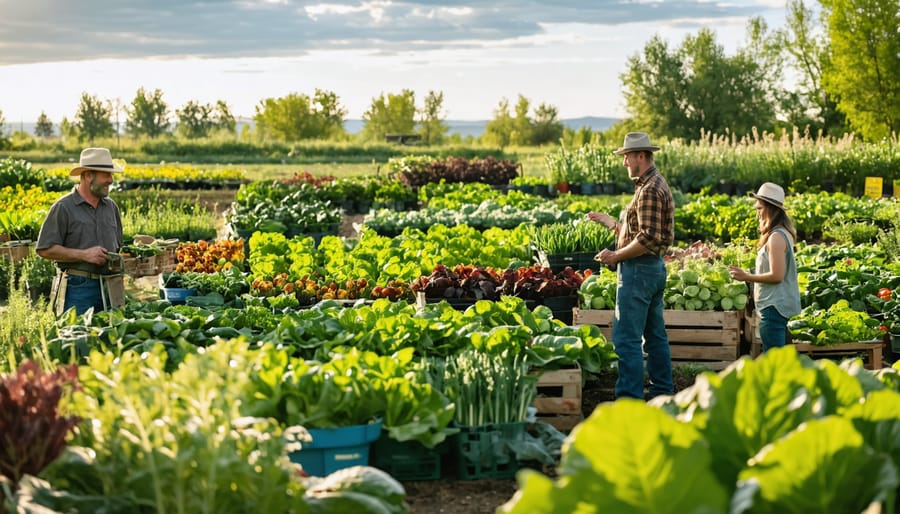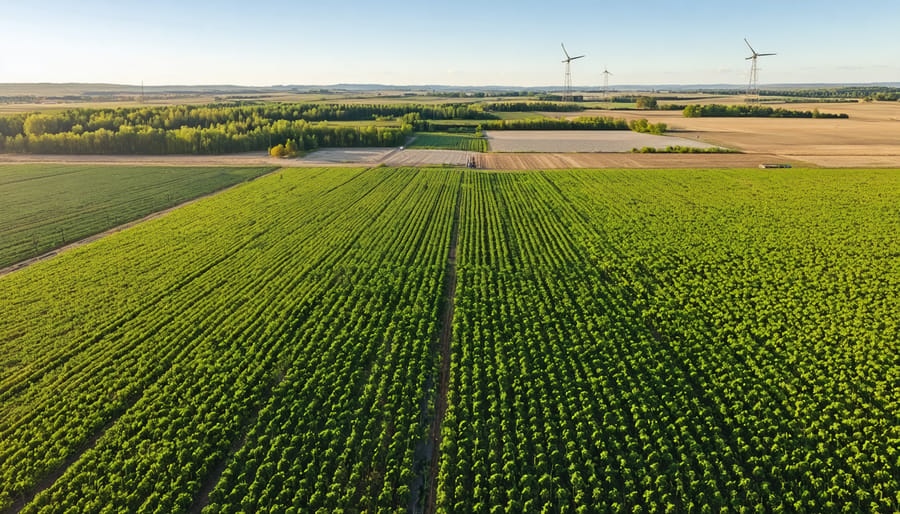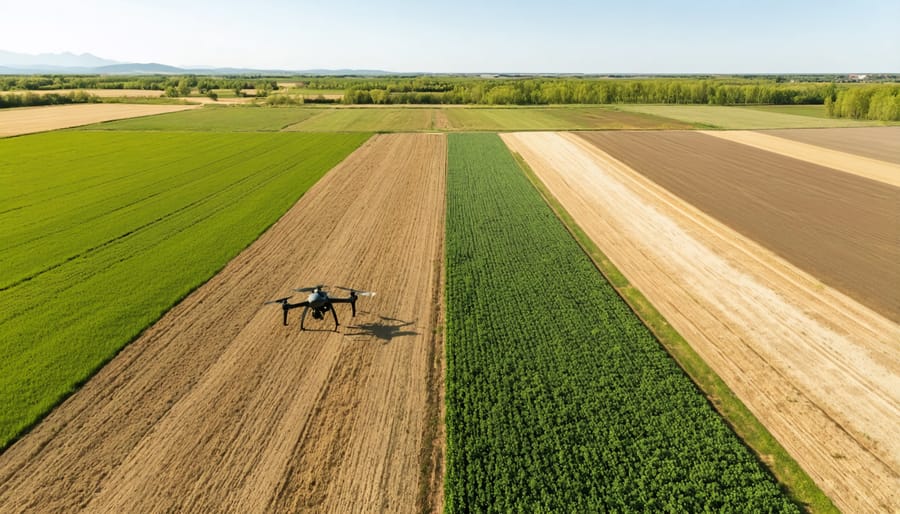Small-scale organic farming transforms modest acreages into thriving agricultural enterprises through essential organic farming practices that maximize both yield and sustainability. Starting with just 2-5 acres, Alberta farmers create profitable operations by focusing on high-value crops like heritage vegetables and medicinal herbs, while implementing intensive planting methods that yield up to four times more produce per square meter than conventional farming.
Modern small-scale organic operations thrive on direct-to-consumer relationships, generating 60-80% higher profits through farmers’ markets and community-supported agriculture programs. These intimate farming models build resilient local food systems while requiring minimal initial investment – typically $20,000 to $50,000 for essential equipment and infrastructure.
The surge in demand for locally-grown organic produce has created unprecedented opportunities for small-scale farmers. With proper crop selection and season extension techniques, Alberta’s small organic farms consistently generate $40,000 to $100,000 per acre annually, proving that significant profit potential exists even on modest land holdings.
Planning Your Small-Scale Organic Farm
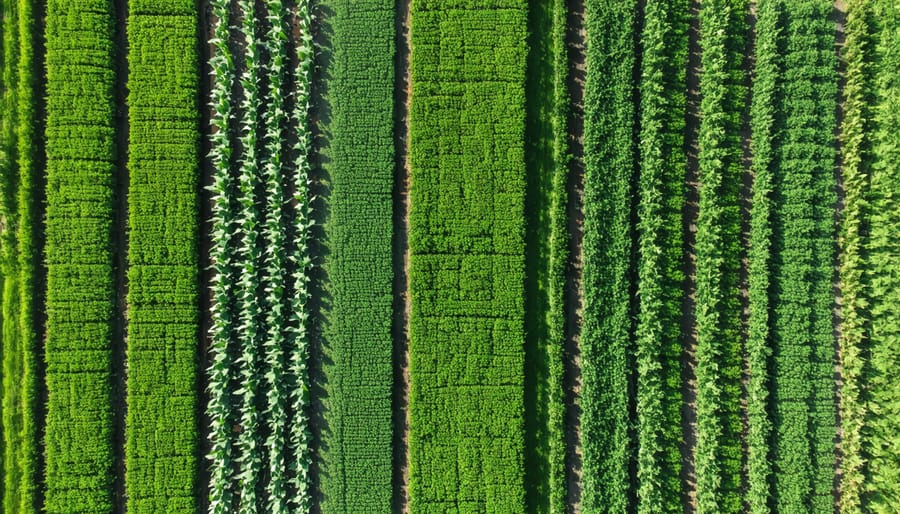
Site Selection and Assessment
Selecting the right location for your small-scale organic farm is crucial for long-term success in Alberta’s diverse agricultural landscape. Start with a thorough soil quality assessment to evaluate fertility, drainage, and organic matter content. Look for well-draining loam soils with a pH between 6.0 and 7.5, which are ideal for most organic crops.
Consider your local microclimate, particularly frost patterns and growing season length. Southern Alberta typically offers 110-120 frost-free days, while central regions may have fewer. Account for wind exposure and natural windbreaks, as strong prairie winds can impact crop growth and soil moisture retention.
Water accessibility is paramount – ensure reliable access to clean water sources for irrigation. Many successful Alberta organic farmers recommend properties with existing wells or water rights. Evaluate the land’s topography; gentle slopes of 2-5% provide good drainage while minimizing erosion risks.
Previous land use history matters significantly. Look for properties that haven’t been treated with prohibited substances for at least three years to qualify for organic certification. Consider proximity to conventional farms to minimize drift concerns and potential contamination.
Access to markets should influence your decision – being within 100 kilometres of urban centers like Edmonton or Calgary can provide valuable direct-to-consumer opportunities while maintaining reasonable land costs. Remember to check local zoning regulations and ensure agricultural activities are permitted on the property.
Crop Selection for Alberta’s Climate
Alberta’s unique climate zones offer excellent opportunities for growing diverse organic crops. In southern Alberta’s zones 3b-4a, heat-loving crops like tomatoes, peppers, and bush beans thrive during the warm summers. The central region, predominantly zone 3a, excels with cold-hardy vegetables such as kale, cabbage, and root crops including carrots and potatoes.
Hardy grains like Red Fife wheat and heritage barley varieties perform exceptionally well across most Alberta growing zones, making them reliable choices for small-scale organic farmers. Local farmer Sarah Thompson from Lacombe reports consistent success with ancient grains like quinoa and amaranth, which have gained popularity in recent years.
For market gardeners, quick-growing crops like lettuce, radishes, and peas offer multiple harvests throughout the season. These crops are particularly suitable for succession planting, maximizing yield from limited space. Cold frames and hoop houses can extend the growing season by up to six weeks on either end, allowing for early spring greens and late fall harvests.
Berries including saskatoons, haskaps, and hardy strawberry varieties are well-adapted to Alberta’s climate and provide excellent diversification options. These perennial crops require minimal annual inputs once established and command premium prices at local markets.
When selecting crops, consider your specific microclimate, soil conditions, and market demand. Successful organic farmers often start with 3-4 primary crops and gradually expand their variety based on performance and customer feedback.
Sustainable Growing Practices
Soil Health Management
Healthy soil is the foundation of successful organic farming, and implementing effective natural soil improvement techniques is crucial for long-term sustainability. Here in Alberta, our varying soil conditions require thoughtful management strategies that work with our unique climate.
Start by conducting regular soil tests to understand your baseline nutrient levels and pH. Most successful organic farmers in our region maintain a robust composting system, incorporating local materials like livestock manure, crop residues, and fallen leaves. Aim for a carbon-to-nitrogen ratio of 30:1 in your compost for optimal results.
Cover cropping is particularly effective in our climate, with red clover and field peas working well for nitrogen fixation. These crops also protect topsoil during our windy seasons and add valuable organic matter when worked back into the soil.
Crop rotation is essential for soil health management. Design a 4-year rotation plan that includes legumes, helping break pest cycles while building soil structure. Many Alberta farmers have found success with combinations of cereals, legumes, and deep-rooted crops like alfalfa.
Minimize soil disturbance by adopting reduced tillage practices where possible. Consider using mulch to retain moisture, suppress weeds, and protect soil biology. Local materials like straw or grass clippings work well and are often readily available from neighbouring farms.
Remember, building healthy soil is a gradual process that requires patience and consistent attention to natural biological processes.
Natural Pest Control
Maintaining a pest-free organic farm doesn’t require synthetic pesticides. Many Alberta farmers have found success with proven pest control strategies that work harmoniously with nature.
Companion planting is particularly effective in our climate. Plant marigolds and nasturtiums along crop borders to deter harmful insects, while attracting beneficial pollinators. Interplanting carrots with onions, or tomatoes with basil, creates natural pest barriers while maximizing growing space.
Beneficial insects are your allies. Encourage ladybugs, praying mantises, and parasitic wasps by maintaining diverse hedgerows and flowering plants. Many Alberta farmers create simple insect hotels using local materials like hollow stems and wood blocks to provide shelter for these helpful creatures.
Physical barriers such as row covers and netting protect young plants during vulnerable stages. For root vegetables, collar guards made from cardboard or newspaper prevent cutworm damage. Regular crop rotation disrupts pest life cycles and maintains soil health.
Biological controls like Bacillus thuringiensis (Bt) and nematodes offer targeted solutions for specific pest problems. These naturally occurring organisms are safe for beneficial insects and human health.
Remember to monitor your crops regularly and maintain detailed records of pest patterns. This helps you anticipate and prevent infestations before they become serious problems, reducing the need for intervention while maintaining crop quality.
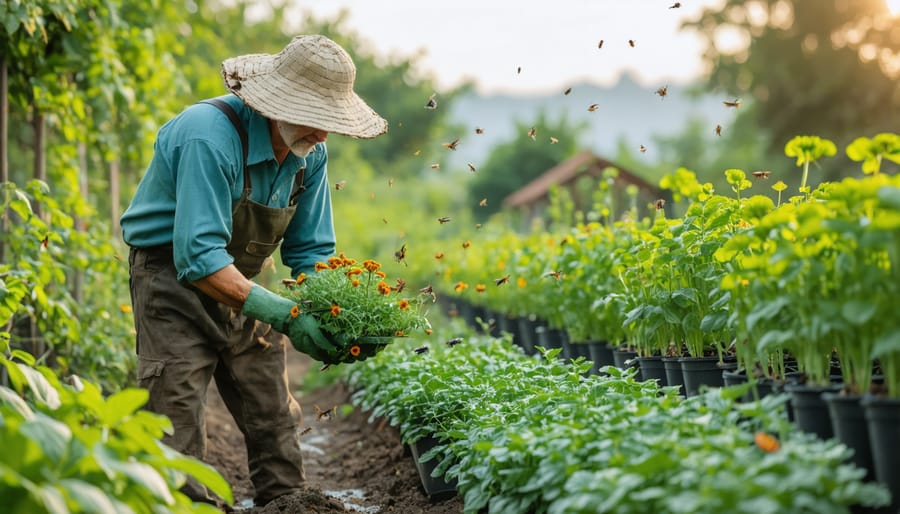
Water Conservation Methods
In Alberta’s semi-arid climate, effective water management is crucial for small-scale organic farming success. Drip irrigation systems have proven particularly effective, reducing water usage by up to 70% compared to traditional sprinkler methods. These systems deliver water directly to plant roots, minimizing evaporation and ensuring optimal moisture levels.
Many Alberta farmers have found success with moisture-retention strategies like mulching and cover cropping. A 15-20 cm layer of organic mulch can significantly reduce water loss while improving soil structure. Local materials like straw or grass clippings work perfectly for this purpose.
Rainwater harvesting is gaining popularity among organic farmers in the region. A typical 1,000-square-metre farm roof can collect up to 600,000 litres of water annually. Storage options range from simple rain barrels to larger underground cisterns, providing valuable irrigation reserves during dry spells.
Soil moisture monitoring tools, such as tensiometers or moisture meters, help farmers make informed irrigation decisions. Regular monitoring allows for precise water application, preventing both under and over-watering. Many successful organic farmers in Alberta combine these tools with weather forecasting to optimize their irrigation schedules.
Time-of-day watering is another crucial strategy. Early morning irrigation (between 5:00 and 8:00 AM) reduces evaporation losses and helps prevent fungal diseases. This approach has helped many local farmers reduce their water consumption by 25-30% while maintaining healthy crop yields.
Marketing and Distribution
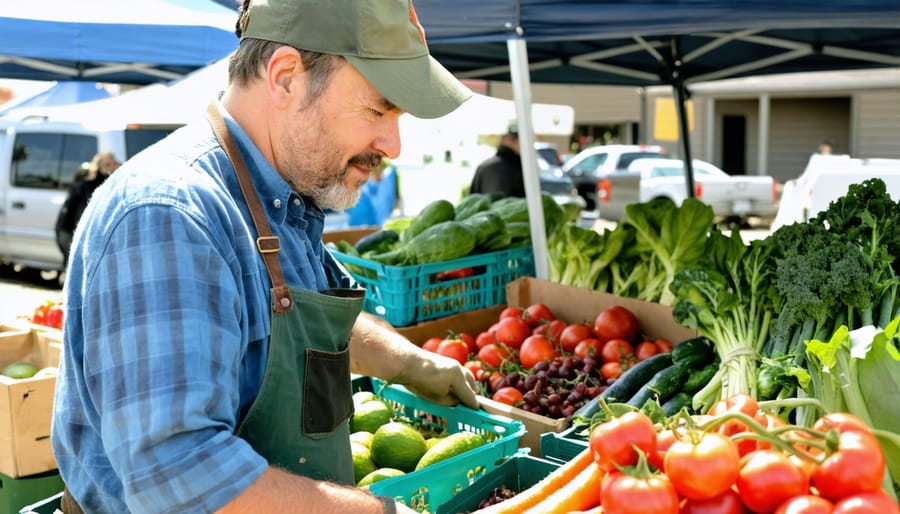
Local Market Opportunities
Small-scale organic farmers in Alberta have numerous market opportunities to sell their produce and build sustainable businesses. Farmers’ markets remain one of the most accessible and profitable channels, with over 130 approved markets across the province providing direct access to conscious consumers. These markets typically operate from May to October, allowing farmers to establish strong community connections and maintain higher profit margins through direct sales.
Community Supported Agriculture (CSA) programs have gained significant traction in recent years, particularly in urban areas like Calgary and Edmonton. Through CSAs, farmers can secure steady income by selling seasonal subscriptions to local customers who receive weekly or bi-weekly produce boxes.
Restaurant partnerships present another viable opportunity, with many Alberta chefs actively seeking local, organic ingredients. High-end restaurants and farm-to-table establishments often value the quality and uniqueness of small-scale organic produce, creating mutually beneficial relationships with local farmers.
Online marketplaces and food delivery services have emerged as promising sales channels, especially following recent shifts in consumer shopping habits. Local food hub initiatives, such as those in Red Deer and Lethbridge, help connect small producers with larger institutional buyers like schools and healthcare facilities.
Farm-gate sales can supplement other revenue streams, particularly for farms located near population centers or tourist routes. Many successful organic farmers combine multiple sales channels to create a diverse and resilient marketing strategy, adapting their approach based on seasonal availability and market demand.
Building Customer Relationships
Building strong customer relationships is the cornerstone of a successful small-scale organic farm in Alberta. Start by identifying your ideal customers at local farmers’ markets and community events, where face-to-face interactions help establish trust and understanding of their needs. Many successful Alberta farmers have found that offering farm tours and harvest days creates memorable experiences that transform casual buyers into loyal supporters.
Consider implementing a Community Supported Agriculture (CSA) program, which has proven particularly effective in building lasting relationships across the province. CSA members become partners in your farming journey, sharing both risks and rewards while ensuring a stable income stream for your operation.
Social media platforms and email newsletters are valuable tools for keeping customers engaged throughout the growing season. Share updates about crop progress, upcoming harvests, and behind-the-scenes glimpses of farm life. Many Alberta organic farmers find success by posting weekly harvest photos and sharing simple recipes featuring their current produce.
Personalized service goes a long way in the organic farming community. Remember customers’ names and preferences, accommodate special requests when possible, and always be transparent about your growing practices. Consider offering loyalty programs, such as early access to popular items or bulk purchase discounts for regular customers.
Regular feedback sessions, whether through surveys or casual conversations, help you understand customer needs and adapt your offerings accordingly. This responsive approach shows customers that their input is valued and helps create a community around your farm.
Real Success Stories
Meet Sarah and Tom Bennett, who transformed their 10-hectare plot near Lacombe into Sunshine Organic Farm, now a thriving operation specializing in heritage vegetables and free-range eggs. Starting in 2018 with just two greenhouses, they’ve expanded to supply five local farmers’ markets and run a successful CSA program serving 75 families.
“The key was starting small and scaling gradually,” Sarah explains. “We focused on soil health from day one and built our customer base through consistent quality and community engagement.” Their farm now generates $180,000 in annual revenue, proving that small-scale operations can be financially viable.
In the Peace Country region, Maria Rodriguez runs Three Sisters Farm, a 6-hectare diversified operation that’s become a model for cold-climate organic farming. Starting with just root vegetables in 2016, Maria now produces everything from microgreens to heritage grains, serving local restaurants and specialty stores in Grande Prairie.
“Understanding our specific growing zone and adapting accordingly was crucial,” Maria shares. “We use season extension techniques and focus on crops that thrive in our shorter growing season.” Her farm’s revenue has grown by 40% annually over the past three years.
Perhaps the most inspiring story comes from the Kumar family near Brooks. Their 4-hectare Sunny Creek Farms specializes in organic herbs and specialty Asian vegetables, filling a niche market in Southern Alberta. Starting with just $50,000 in savings, they’ve built a profitable operation that now includes a value-added product line of dried herbs and specialty teas.
“We discovered that success in small-scale organic farming isn’t just about growing food,” explains Raj Kumar. “It’s about building relationships with customers who share our values and appreciate the quality of organic produce.” Their farm now supports three full-time family members and two seasonal workers, with annual sales exceeding $200,000.
Small-scale organic farming offers a viable path to sustainable agriculture in Alberta, combining traditional wisdom with modern innovation. Throughout this guide, we’ve explored essential aspects from soil management to market opportunities, demonstrating that success is achievable with proper planning and dedication. The growing demand for local, organic produce presents an exciting opportunity for farmers willing to make the transition.
Remember, every successful organic farm started with a single step. Whether you’re looking to convert existing farmland or start fresh, Alberta’s agricultural community stands ready to support your journey. Connect with local organic farming associations, attend workshops, and learn from experienced producers in your area. By embracing sustainable practices and building strong community relationships, you can contribute to a more resilient food system while creating a profitable agricultural enterprise.
Take that first step today – your sustainable farming future awaits.

